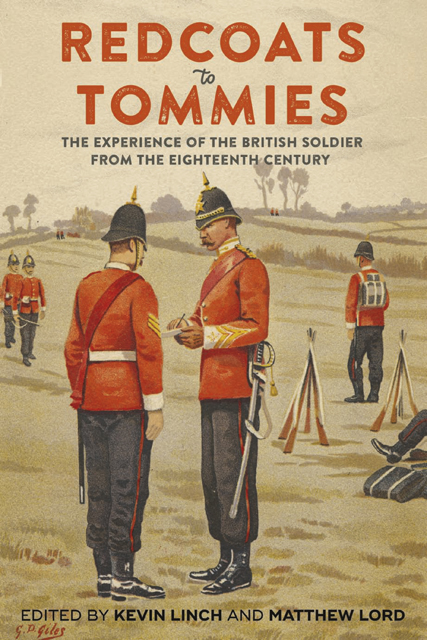8 - ‘A Soldier’s Life is a Merry One’, or, ‘A Certain Cure for Gout and Rheumatism’: The Shift in Popular Perceptions of the Common Soldier in Late Victorian Britain, 1870–c.1910
Published online by Cambridge University Press: 17 January 2023
Summary
The cartoons ‘“A Soldier’s Life is a Merry One”’ and ‘A Certain Cure for Gout and Rheumatism’ were published by Illustrated Chips on 22 November 1890. It could be argued that they are in poor taste. J. W. Richards’ illustrations are darkly humorous as he suggests that losing a leg on the battlefield is a ‘Certain Cure for Gout and Rheumatism’, although of course, he is technically correct. And, to accompany a sketch of British soldiers charging into volley fire with the caption, ‘A Soldier’s Life is a Merry One’, is sardonic to say the least. However, Illustrated Chips had not set out to denounce military service. Both cartoons appeared on the same double-page spread surrounded by other illustrations which were not related to the military. Other jokes poked fun at the hazards of serenading women armed with cricket bats, or the folly of a man visiting his hatter before his barber. This November issue of Illustrated Chips makes no further reference to the soldier or the army, nor do immediately previous and subsequent editions of the comic. These jokes are self-contained comic-book ‘gags’ intended to entertain. Despite their air of cynicism, however, the illustrations epitomise a shift in the way in which the regular army in Britain, and the common soldier of the rank and file in particular, was viewed and presented over the course of the late nineteenth century. They are not overly sentimental or sympathetic. Nor do they explicitly reference debates concerning the conditions of military service. But, crucially, the soldier is the focus. ‘A Soldier’s Life’ and ‘A Certain Cure’ suggest a civilian awareness of the soldier and a willingness to engage, albeit briefly, with the realities and potential dangers of life in the British army. They reflect, and even mock, the late Victorian fascination with the ordinary soldier and the growing enthusiasm for military themes as entertainment, which had emerged in popular culture by 1900.
The British public had, of course, always been aware of the soldier. However, in general, and in peacetime in particular, the public traditionally engaged with the regular British army primarily at an institutional level.
- Type
- Chapter
- Information
- Redcoats to TommiesThe Experience of the British Soldier from the Eighteenth Century, pp. 169 - 191Publisher: Boydell & BrewerPrint publication year: 2021



